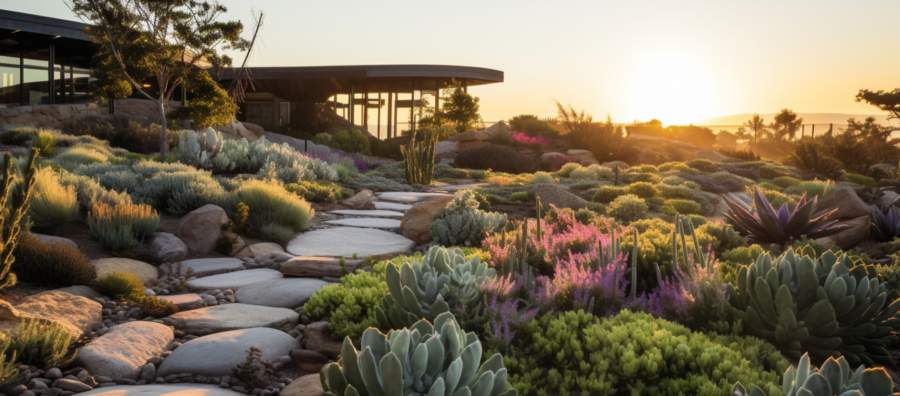Drought-Resistant Plants for Sustainable Landscaping

Introduction to the Green Scene
Picture this, baby: the sun is scorching your backyard, turning your once lush, verdant lawn into something resembling a crispy piece of toast. Before you grab the hose and drench your parched plants in a deluge of H2O, consider the fact that water is a finite resource. As the planet continues to warm up, droughts are becoming more frequent and severe, and responsible gardeners are adapting by embracing sustainable landscaping practices. The solution? Drought-resistant plants, man!What Makes a Plant Drought-Resistant?
That's the million-dollar question, isn't it? Drought-resistant plants have developed an array of groovy adaptations to help them survive in arid environments. These can include deep root systems for tapping into underground water supplies, fleshy leaves for storing water, or small leaves to reduce water loss through transpiration. It's all about survival of the fittest out there in the plant world, and these bad boys have evolved to beat the heat.Low-Water Landscaping: Not Just Cacti and Succulents
When you think of drought-resistant plants, your mind might immediately jump to cacti and succulents, but there's a whole world of flora out there just waiting to be discovered by your parched little green thumb. Here are some categories to get your juices flowing:- Perennials: Tough, hardy perennials like lavender, Russian sage, and yarrow can add color and fragrance to your garden without guzzling water like there's no tomorrow.
- Grasses: Ornamental grasses such as blue fescue, pampas grass, and fountain grass are low-maintenance and offer a cool, calming vibe to your landscape.
- Shrubs: Check out drought-tolerant shrubs like California lilac, rockrose, or manzanita for some serious curb appeal.
- Trees: For a long-term investment in your low-water landscape, plant drought-resistant trees like olive, mesquite, or palo verde.
Get to Know Your Local Flora
When selecting plants for your drought-resistant garden, it's crucial to keep in mind the characteristics of your local ecosystem. Some plants might thrive in the dry heat of the Southwest, but wither away in the cooler, foggy climates of the coast. On the flip side, some plants might be perfectly suited to arid environments, but quickly become invasive and threaten native species. That's why it's essential to do some research and consult with local experts before you start tossing seeds around like a flower-crazed Johnny Appleseed.Designing Your Drought-Resistant Garden
So, you've got a veritable smorgasbord of plants to choose from, but how do you go about designing your drought-resistant garden? Here are a few tips to get you started:- Zones: Think about the layout of your garden and group plants with similar water requirements together. This will make it easier to manage your watering and ensure that the thirstiest plants aren't stealing all the precious moisture from their drought-resistant neighbors.
- Mulch: Cover the soil around your plants with a layer of mulch to help retain moisture, suppress weeds, and regulate temperature. As an added bonus, organic mulches like wood chips or straw will break down over time, improving the quality of your soil and making your plants even more drought-tolerant.
- Irrigation: When it comes to watering your drought-resistant garden, drip irrigation is where it's at. By delivering water directly to the root zones of your plants, you'll minimize water loss through evaporation and runoff, and make sure that every precious drop is put to good use.
- Maintenance: Keep an eye on your garden and prune dead or dying plant material to encourage new growth and prevent disease. At the same time, don't go too crazy with the pruning shears, as removing too much foliage can actually increase water loss through transpiration.
Embrace Your Inner Water-Wise Wizard
By incorporating drought-resistant plants into your landscape, you're not only conserving water and protecting the environment, you're also creating a groovy, low-maintenance garden paradise for yourself and the local wildlife. So go ahead, take the plunge into the world of sustainable landscaping, and let your green thumb do its part to save the planet, one dry-as-a-bone plant at a time!Article kindly provided by yourhomengarden.org
Latest Articles
- Simple Design Tricks That Encourage Backyard Biodiversity
- Why Your Showerhead Is Suffering From a Mineral Midlife Crisis
- Gateways That Turn Heads While Keeping Your Property Safe
- Listening Pipes: Using Sound to Diagnose Hidden Home Plumbing Issues
- Small Changes That Make a Kitchen Feel Completely New
- Scents That Refuse to Leave and How to Outwit Them
- How Personalisation Makes Homewares Feel Special
- Asphalt Advantage and the HOA Budget Balancing Act
- The Step-By-Step Process of Turning a Garden Vision into Reality
- Rain Doesn't Fall Straight: Why Roof Shape and Wind Matter More Than You Think
- How Fire Pit Design Quietly Shapes Human Connection
- Invisible Passengers Who Never Pay the Fare
- When the Ground Has Opinions: Learning to Hear Tree-Soil Conversations
- When Windows Sweat: What Condensation Reveals About Your Home's Hidden Climate
- Vertical Micro-Oasis for Kitchen Herbs in Tight Urban Spaces
- Why Clean Workspaces Quietly Boost Creativity
- Color-Coding Your Backyard: a Homeowner's Guide to Safe DIY Marking
- Invisible Safety in Bathrooms that Still Feel Like a Spa
- How Orientation Shapes Your Extension's Energy Efficiency
- How Floor Patterns Change How a Room Is Perceived
- Interior Design
- Home Improvement
- Gardening
- Home Organization
- Home Maintenance
- DIY Crafts
- Kitchen and Dining
- Bathroom Design
- Home Security
- Home Automation
- Green Living
- Home Office
- Home Decor
- Garden Design
- Pet Care
- Home Technology
- Landscaping
- Home Energy Efficiency
- Home Cleaning
- Home Safety
- Home Exterior
- Home Insulation
- Home Buying
- Home Selling
- Renting
- Tradespeople
- Garage
- Bedroom
- Painting and Decorating
- Plumbing and Drainage

